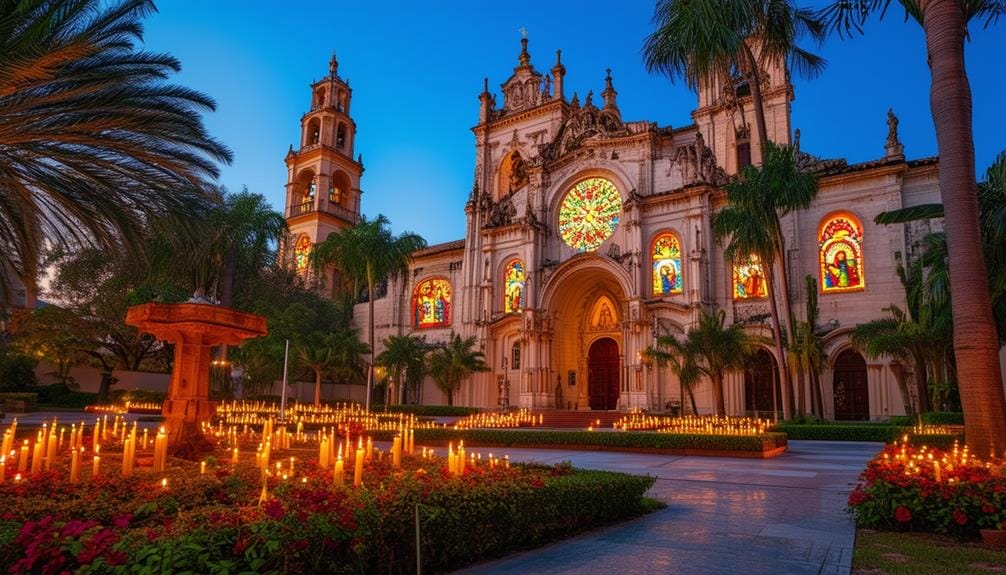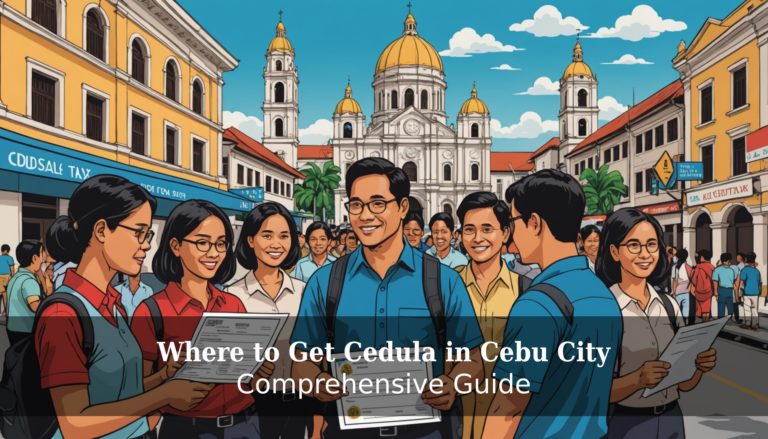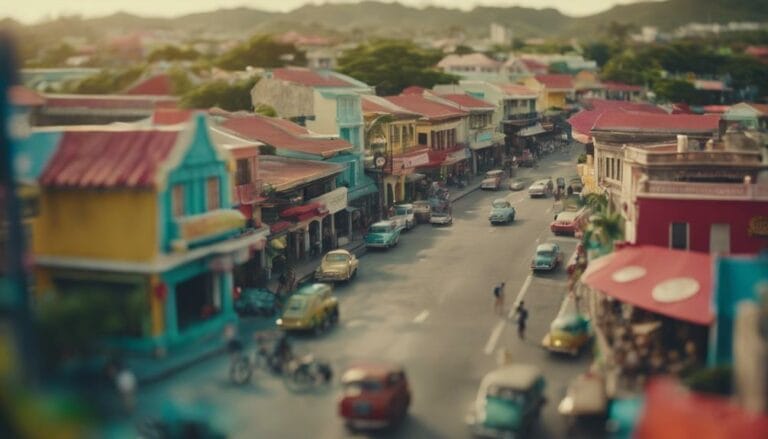Basilica Sto Nino History
When you explore the history of the Basilica Sto Niño, you'll uncover its founding on April 28, 1565, by Fray Andrés de Urdaneta and Fray Diego de Herrera. This significant event marked the beginning of Christian worship in the Philippines, following the discovery of the Santo Niño de Cebu image. Yet, the story doesn't end there. The basilica has weathered multiple fires, an earthquake, and numerous reconstructions, evolving into a resilient symbol of Filipino faith. But what exactly transformed this historic site from its humble beginnings to its current grandeur? There's much more to reveal.
Key Takeaways
- Founded on April 28, 1565, by Fray Andrés de Urdaneta and Fray Diego de Herrera.
- Current Basilica structure was built between 1735 and 1740 in Earthquake Baroque style.
- Declared a National Historical Landmark on August 1, 1973.
- Designated as a National Cultural Treasure on April 14, 2021.
- Annual Sinulog Festival celebrates Santo Niño, attracting thousands for religious and cultural festivities.
Founding and Early Years
Although many historical landmarks are steeped in rich narratives, the founding and early years of the Basilica del Santo Niño stand out for their foundational significance to the Philippines. The Basilica was founded on April 28, 1565, by Fray Andrés de Urdaneta and Fray Diego de Herrera, marking the establishment of the oldest Roman Catholic church in the country.
The discovery of the image of Santo Niño de Cebu by Juan Camus on May 8, 1565, among the ruins of a burnt church, was pivotal. This event spurred the establishment of the first Spanish settlement in Cebu, embedding the Santo Niño deeply into the cultural and religious fabric of the Philippines.
Despite its early significance, the first church constructed on this site faced numerous challenges. The initial structure, built shortly after the image's discovery, was destroyed by fire on November 1, 1566.
Subsequent efforts to rebuild saw another church constructed in 1605 and completed by 1626, only to be similarly ravaged by flames. These early trials underscored the resilience of the settlers and their dedication to maintaining a place of worship.
The current Basilica, constructed from 1735 to 1740, stands as a monument to these foundational years and their enduring legacy.
Architectural Evolution
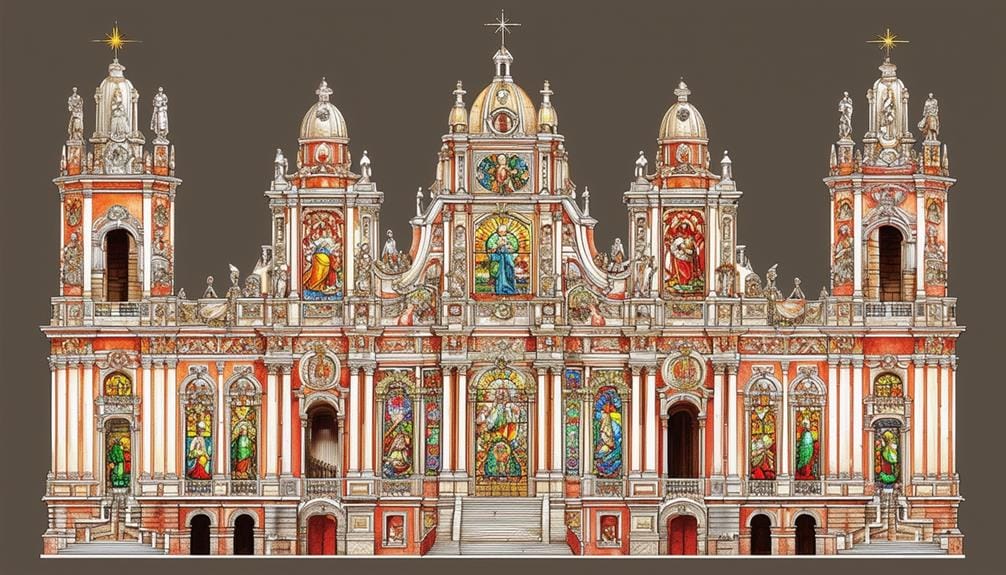
The architectural evolution of the Basilica del Santo Niño is a tribute to both the resilience and ingenuity of its builders. The original church, constructed in 1566, succumbed to fire, prompting successive reconstructions in 1605 and 1628, which also met similar fates.
However, the present structure, completed between 1739 and 1740, embodies the Earthquake Baroque architectural style, using stone materials designed to withstand seismic activities.
The foundation for this enduring basilica was laid on February 29, 1735, highlighting the community's dedication and the leadership of church authorities. Major renovations in 1789 and 1889 guaranteed the building's stability and aesthetic integrity.
Remarkably, in 1965, significant restoration efforts were undertaken to commemorate the fourth centennial of Christianization in the Philippines, emphasizing the basilica's cultural and spiritual significance.
The 7.2-magnitude earthquake in 2013 necessitated extensive restoration starting in July 2015. This work focused on preserving the historical features while guaranteeing structural compatibility with modern standards.
Today, the Basilica del Santo Niño stands as a reflection of the adaptive spirit of its constructors, seamlessly blending historical reverence with contemporary resilience.
Historical Milestones
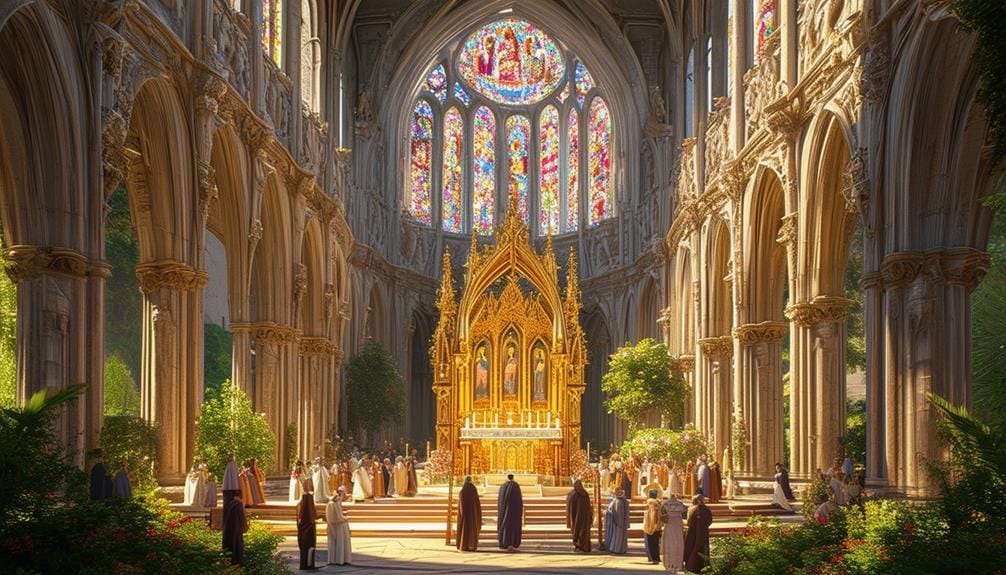
Founding on April 28, 1565, the Basilica del Santo Niño stands as a significant landmark in Philippine history. Fray Andrés de Urdaneta and Fray Diego de Herrera established it, marking the beginning of the first Spanish settlement in the Philippines.
The discovery of the original image of Santo Niño de Cebu by Juan Camus on May 8, 1565, in the ruins of a burnt church, led to the construction of the first Christian church on that site.
The first church, built in 1566, was destroyed by fire, as were subsequent constructions in 1605 and 1628. The current structure, which you can still see today, began construction on February 24, 1735, and was completed on January 16, 1740. This iteration was built using stone materials and showcases the Earthquake Baroque architectural style, designed to withstand seismic activity.
The Basilica del Santo Niño was declared a National Historical Landmark on August 1, 1973, recognizing its historical significance.
More recently, on April 14, 2021, it was designated as a National Cultural Treasure, aligning with the 500th anniversary of the first baptism in the Philippines. These milestones underscore the Basilica's enduring legacy and importance.
Cultural Significance

You'll find that the Santo Niño de Cebu holds immense cultural significance as a potent symbol of Filipino faith, deeply cherished nationwide.
The annual Sinulog festival underscores this importance, drawing thousands who participate in devotional practices and traditional dances that celebrate the Holy Child.
These festivities and rituals highlight the enduring cultural connection and reverence Filipinos have for the Santo Niño.
Symbol of Filipino Faith
Revering the Santo Niño de Cebu as a national cultural treasure underscores the profound Catholic faith deeply embedded in Filipino identity. This veneration is not just a matter of religion; it's a reflection of the collective Filipino spirit. The Santo Niño represents hope, protection, and guidance, resonating deeply within the hearts of many Filipinos.
The annual Sinulog festival epitomizes this devotion. Thousands of devotees and tourists flock to Cebu, creating a vibrant tapestry of faith and culture. The rituals, such as kissing the statue's foot, highlight the intimate personal connections Filipinos have with the Santo Niño. These acts are more than mere tradition; they are expressions of a deep-rooted spiritual bond.
The Traslacion event and the fluvial procession further solidify this bond, turning community gatherings into profound cultural expressions. These events showcase the collective devotion and emphasize the Santo Niño's role in providing hope and protection.
| Event | Significance | Cultural Impact |
|---|---|---|
| Sinulog Festival | Celebrates Santo Niño | Draws thousands, showcasing devotion |
| Statue Kissing | Personal reverence | Strengthens personal connections |
| Traslacion | Symbolic transfer of Santo Niño | Highlights community's spiritual journey |
| Fluvial Procession | Maritime procession of the image | Emphasizes the Santo Niño's protective role |
| Community Gatherings | Collective acts of devotion | Fosters unity and shared cultural identity |
These elements underscore how the Santo Niño de Cebu remains a powerful symbol of Filipino faith and identity.
Sinulog Festival Importance
How does the Sinulog Festival capture the essence of Filipino cultural identity and faith? The annual celebration in Cebu City, held every third Sunday of January, honors Santo Niño and attracts thousands of devotees and tourists alike. This vibrant event is more than just a religious observance; it's a profound expression of the Philippines' rich cultural heritage and spiritual connection.
During the Sinulog Festival, you'll witness vibrant street parades and traditional dances that reflect the rhythmic movement of water, symbolizing the locals' conversion to Christianity. Chanting "Viva! Pit Señor!" participants express their deep devotion to Santo Niño, highlighting the powerful spiritual connection many Filipinos feel.
The series of novena masses leading up to the feast day underscores the religious importance of the festival, deeply rooted in the community's faith.
However, the festival's impact extends beyond spirituality. It considerably boosts tourism, drawing visitors from around the world and providing a substantial economic uplift to Cebu City. Local businesses, including hotels, restaurants, and shops, thrive during this period, capitalizing on the influx of tourists eager to experience the vibrant festivities. Many visitors also take the opportunity to explore iconic spots like the Taboan Market in Cebu City, renowned for its variety of dried fish and other regional delicacies. This bustling marketplace not only highlights Cebu’s culinary heritage but also contributes to the local economy, making the festival season a win-win for both the city’s cultural preservation and its financial growth.
The Sinulog Festival encapsulates the essence of Filipino identity through its seamless blend of faith, culture, and economic vibrancy, making it an event of immense significance to both the local community and the nation's cultural landscape.
Devotional Practices Highlight
Amidst the vibrant celebrations of the Sinulog Festival, the devotional practices surrounding the Santo Niño stand out as a demonstration to the profound cultural and spiritual significance this religious icon holds for Filipinos. The Santo Niño, venerated as a national cultural treasure, symbolizes Filipino identity and faith. Devotees display their devotion through various rituals, such as kissing the statue's foot, reflecting a deep, personal connection to the Santo Niño.
The Sinulog festival itself, which honors the Santo Niño, showcases the integration of cultural heritage and religious fervor. Thousands of devotees and tourists participate in traditional dances and street parades, underscoring the community's shared values and beliefs. The Traslacion event in Mandaue City, a 35-year tradition, further exemplifies this devotion. This grand procession reenacts significant historical events, allowing participants to engage deeply with their cultural and spiritual heritage.
| Aspect | Description |
|---|---|
| Santo Niño | Venerated as a national cultural treasure and beloved religious icon. |
| Devotional Acts | Kissing the statue's foot, showcasing personal devotion and connection. |
| Sinulog Festival | Celebrates cultural heritage through dances and parades, attracting thousands. |
| Traslacion | A 35-year tradition in Mandaue City, re-enacting historical events. |
| Cultural Heritage | Expressed through body movements and visual displays, integrating faith and tradition. |
These practices at the Basilica Minore del Santo Niño highlight the enduring significance of religious icons in Filipino culture, reinforcing a collective identity rooted in faith and tradition.
Annual Celebrations
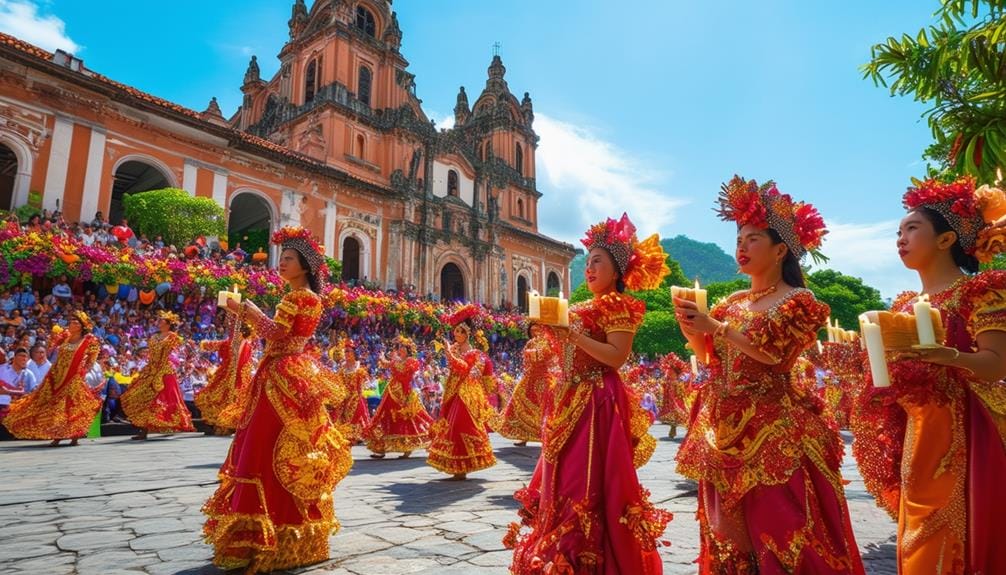
The annual celebrations of the Santo Niño in Cebu City culminate in the grand Sinulog festival, held every third Sunday of January, drawing thousands of devotees and tourists alike. This vibrant event features a spectacular street parade lasting 9 to 12 hours, showcasing traditional music, dance, and colorful costumes that vividly reflect Filipino culture.
The Sinulog festival isn't just a feast for the senses but also a deeply spiritual occasion, emphasizing the Santo Niño's spiritual significance through a series of religious activities.
A novena, consisting of nine days of masses, leads up to the feast day, underscoring the collective devotion of the participants. One of the most moving events is the dawn procession, where the image of Santo Niño is paraded through the streets, attracting large, reverent crowds. This procession symbolizes the profound devotion and faith of the attendees.
The celebrations conclude with the Hubo rite, a ceremonial undressing of the Santo Niño statue. Accompanied by festive drum rolls, this rite allows devotees to offer personal petitions, marking an introspective end to the annual festivities.
Each element of the Sinulog festival—from the street parade to the dawn procession and Hubo rite—reflects the deep-rooted cultural and spiritual devotion to the Santo Niño.
Earthquake and Restoration
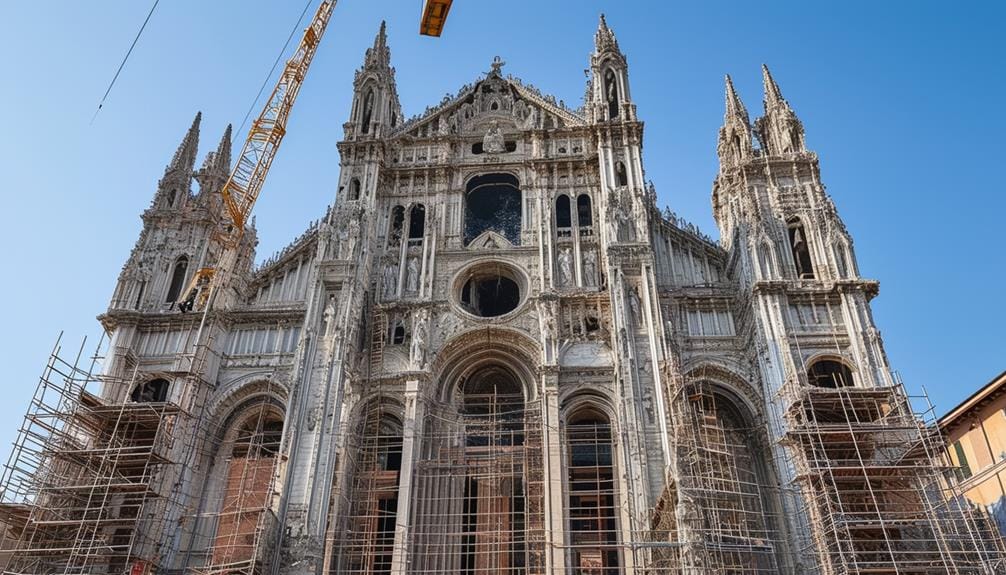
Suffering significant damage from a 7.2-magnitude earthquake on October 15, 2013, the Basilica del Santo Niño faced a challenging period of restoration and recovery. The earthquake destroyed the belfry and façade, and left cracks in the walls and frescoes, necessitating immediate intervention.
During the restoration process, masses were temporarily relocated to the Pilgrim Center to guarantee the safety of worshippers and visitors.
Restoration efforts began in earnest by July 2015, focusing on structural compatibility to address the extensive damage. The primary goal was to preserve the basilica's historical features while making sure it met modern safety standards.
Specialists undertook major renovations, meticulously cleaning and repairing the damaged areas to restore the basilica's former glory.
A significant milestone was achieved with the complete restoration of the belfry by October 2016, symbolizing progress in the broader recovery efforts.
These renovations were essential not only for the structural integrity of the Basilica del Santo Niño but also for maintaining its historical and cultural significance.
The restoration process demonstrated a commitment to preserving heritage while adapting to contemporary safety requirements, ensuring the basilica remained a cherished landmark for future generations.
Museum and Library
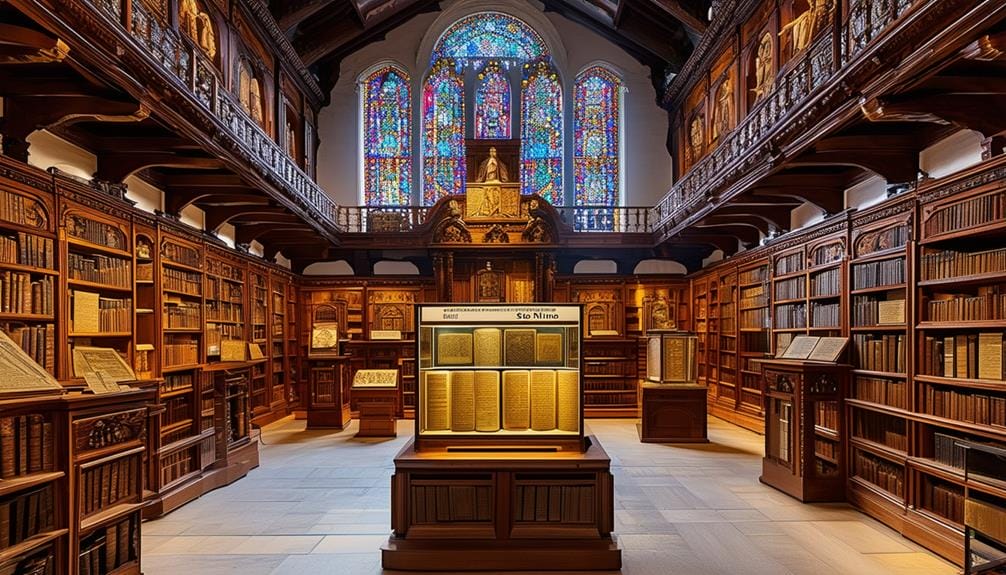
You'll find the Basilica del Santo Niño's museum, established in 1965, an essential visit for its notable antique collections, including 17th-century church documents and old vestments.
The library, opened in 2000, offers accessible research resources, containing a variety of subjects from history to Filipiniana.
Together, these institutions provide a thorough archive of historical documents, enriching your understanding of the basilica's significance and the Catholic faith in the Philippines.
Notable Antique Collections
Nestled in the heart of Cebu, the museum at the Basilica del Santo Niño offers a fascinating glimpse into the rich tapestry of Philippine Christian history. Established in 1965 by Fr. Ambrosio Galindez, O.S.A., this museum commemorates the Fourth Centennial of Christianization in the Philippines. You'll find an impressive array of antique church furniture and 17th-century documents, including old vestments of the Santo Niño de Cebu, showcasing the depth of religious artifacts and history.
Located in the basement of the Pilgrim Center, the museum serves as a repository for these priceless collections. Each piece tells a story, contributing to a broader understanding of the region's religious journey.
| Collection | Highlights |
|---|---|
| Antique Church Furniture | Intricately carved pieces from the 16th and 17th centuries |
| 17th-Century Documents | Letters and decrees essential to Philippine Christian history |
| Santo Niño Vestments | Ornate garments detailing the devotion to Santo Niño de Cebu |
The Basilica del Santo Niño Library, opened to non-clerical researchers in 2000, is another treasure trove. It houses diverse collections spanning religious subjects, history, science, philosophy, and Filipiniana. Periodicals enrich scholarly research, making it a significant resource for anyone interested in the Christianization of the Philippines.
Accessible Research Resources
Within the Basilica del Santo Niño, the museum and library provide invaluable resources for researchers delving into Philippine Christian history. Established in 1965 by Fr. Ambrosio Galindez, O.S.A., the museum boasts 17th-century church documents and antique church furniture, including the vestments of Sto. Niño de Cebu.
Located in the basement of the Pilgrim Center, it commemorates the Fourth Centennial of Christianization in the Philippines, making it a treasure trove for those interested in this transformative period.
The library, opened to non-clerical researchers in 2000, offers a rich collection spanning religious topics and non-religious disciplines such as history, science, philosophy, and Filipiniana. Initially exclusive to friars, the library now provides broader access to scholarly resources, including periodicals essential for in-depth study.
This shift enhances the understanding of the historical and cultural significance of the Santo Niño image and its associated practices.
Continuous research and documentation by local news and academic sources further enrich the available research resources. With these tools at your disposal, you can explore the extensive history and cultural impact of the Basilica del Santo Niño, contributing to a deeper, more nuanced understanding of Philippine Christian history.
Historical Document Archives
Amid the rich history encapsulated by the Basilica del Santo Niño, the museum and library stand out as vital repositories for historical documents and artifacts. Established in 1965 by Fr. Ambrosio Galindez, O.S.A., the museum commemorates the Fourth Centennial of Christianization in the Philippines.
Nestled in the basement of the Pilgrim Center, the museum houses an impressive array of 17th-century church documents, antique church furniture, and old vestments of Sto. Niño de Cebu.
When you visit, you'll find that these treasures offer a tangible connection to the past, meticulously preserved to guarantee the continuity of historical knowledge.
The library, opening its doors to non-clerical researchers in 2000, further enriches this experience. It offers a vast collection of religious and non-religious materials, spanning history, science, philosophy, and Filipiniana, essential for anyone dedicated to thorough research.
The library's archives, filled with periodicals and other resources, play a significant role in the preservation of historical knowledge.
Both the museum and library at the Basilica del Santo Niño serve as invaluable resources, guaranteeing that the rich heritage of the Sto. Niño de Cebu and the basilica's significance remain accessible and preserved for future generations.
Frequently Asked Questions
What Is the Story Behind Santo Niño?
You explore Santo Niño's significance through its historical origins, cultural impact, and religious devotion. Miracles attributed to it, festivals celebrated, and artistic representations inspire pilgrimage traditions, global influence, and community celebrations, emphasizing its enduring legacy.
What Is the Basilica Del Santo Niño Famous For?
You'll find the Basilica del Santo Niño famous for its cultural significance, stunning architectural features, and role as a pilgrimage site. It hosts religious celebrations, showcases historical artifacts, and offers enriching visitor experiences through community events and spiritual practices.
Is Santo Niño Baby Jesus?
Yes, Santo Niño is the Baby Jesus, a Catholic icon with historical significance. It represents religious devotion, cultural heritage, and spiritual symbolism. This artwork has global influence, making pilgrimage sites significant for its representation.
What Do the Colors of the Santo Niño Dress Mean?
The colors of the Santo Niño dress hold deep symbolism: red signifies festivity, gold denotes divinity, blue represents peace, and white stands for purity. Understanding these hues reveals the rich cultural interpretations and religious implications in community celebrations.
Conclusion
You've journeyed through the rich history of the Basilica Sto Niño, from its founding by Urdaneta and Herrera to its resilience through disasters. The architectural evolution, marked by Earthquake Baroque, and its historical milestones highlight its enduring significance. The annual Sinulog Festival and the museum and library further underscore its cultural importance. Despite challenges, the Basilica remains an essential religious and cultural hub, embodying the enduring faith and spirit of the Filipino people.

